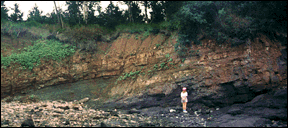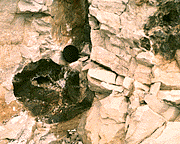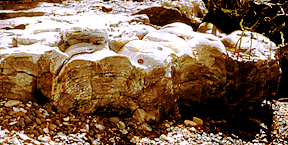

The Early Jurassic age McCoy Brook Formation is the youngest syn-rift unit recognized in the Fundy basin. Mostly it consists of fluvial to lacustrine red beds (see the Field Trip for Day 4). However, a regionally extensive relatively thin lacustrine, often carbonate-rich sequence occurs at the base of the formation in outcrop. Exposures of this basal unit occur in a few depressions on top of the North Mountain Basalt on the south shore of Scots Bay, Nova Scotia. These are particularly rich in limestone and were termed the Scots Bay Formation.

These outcrops, which were visited, consist predominately of white limestone and red to black chert, interbedded green and red mudstone, and brown sandstone. The limestone is rich in charophyte debris and locally, coquinas comprised of minute snails and clams. Fossil fish and rare tetrapod bones occur locally, as do reptile footprints. The most obvious fossils, however, are the abundant stromatolite-encrusted tree limbs (left) and layers of domal stromatolites (below).
